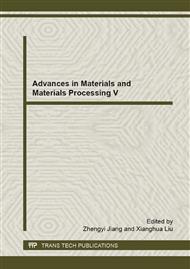[1]
Sevda Altaş, Gűlşah Pamuk, Ultrasonic Energy in the Textile Indutry, AATCC Review, 2007. Vol. 36, pp.29-31.
Google Scholar
[2]
V.G. Gutnik N.V. Gorbach A.V. Pashkov, Some Characteristics of Ultrasonic Welding of Polymer, Fibre Chemistry, 2002. Vol. 34 No. 6, pp.426-432.
Google Scholar
[3]
M. Shakil, N.H. Tariq, M. Ahmad , M.A. Choudhary , J.I. Akhter , S.S. Babu , Effect of ultrasonic welding parameters on microstructure and mechanical properties of dissimilar joints, Materials and Design, 2014. Vol. 55, pp.263-273.
DOI: 10.1016/j.matdes.2013.09.074
Google Scholar
[4]
Peiqing Jiang, Yifei Lai, Xianshan Chen, Seam Mechanical Properties of Polyeater/Cotton Blended Woven Fabric Welded by Ultrasonic Sewing Machine, Journal of Donghua University (Nature Science). 2013. Vol. 39. (3), pp.283-285.
Google Scholar
[5]
Luminita VLAD, Mitu STAN, Crina BUHAI, The Optimization of the Assemblies Applied to Products Made of Waterproof Fabrics, TEKSTİL ve KONFEKSİYON, 2013, 23(2), pp.273-279.
Google Scholar
[6]
Chanliang Chen, Ultrasonic Welding Technology, Electric Processing, 1989(5), pp: 15-22.
Google Scholar
[7]
K.S. Suresh, M. Roopa Rani, K. Prakasan, R. Rudramoorthy Modeling of temperature distribution in ultrasonic welding of thermoplastics for various joint designs, Journal of Materials Processing Technology, 2007(186). pp.138-146.
DOI: 10.1016/j.jmatprotec.2006.12.028
Google Scholar
[8]
A. Slade, The Uses of High Frequency Welding in the Textile Industry, TEXTILE INSTITUTE AND INDUSTRY, 1964, pp.131-134.
Google Scholar
[9]
Weihua Shi, Trevor Little, Mechanisms of ultrasonic joining of textile materials, International Journal of Clothing Science and Technology, 2000, Vol. 12 No. 5, pp.331-350.
DOI: 10.1108/09556220010377869
Google Scholar
[10]
ŽivilėJAKUBČIONIENĖ, Vitalija MASTEIKAITĖ, Investigation of Textile Bonded Seams, Materials Science, 2010, Vol. 16 No. 1, pp.76-79.
Google Scholar
[11]
Vladimir N. Khmelev, Aleksey N. Slivin, Andrey V. Lehr, Aleksey D. Abramov,Theoretical Investigations of Continuous Ultrasonic Seam Welding of Thermoplastic Polymers and Fabrics, Xi International Conference and Seminar EDM, 2010, Section IV, pp.341-344.
DOI: 10.1109/edm.2010.5568791
Google Scholar
[12]
Kerrie Boles, Examination of Alternative Fabric Joining Techniques Compared to Traditional Sewing, McNair Scholars Research Journal, 2012, Vol. 5 Issue 1, pp.1-17.
Google Scholar
[13]
Eric Violleau, Ultrasonic Welding for Composite Materials, JEC COMPOSITES MAGAZINE, 2014, No. 4(87), pp.92-94.
Google Scholar


